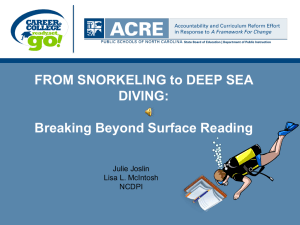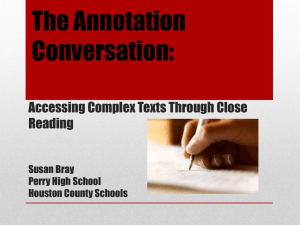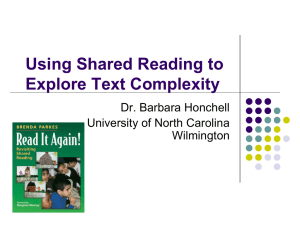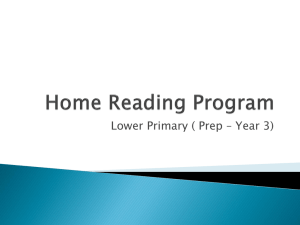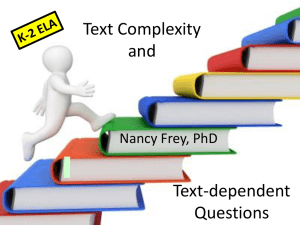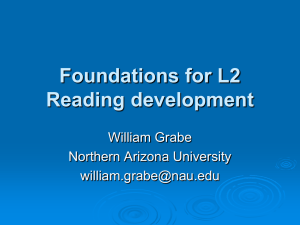Close Reading - 2014ELASummerInstitute
advertisement
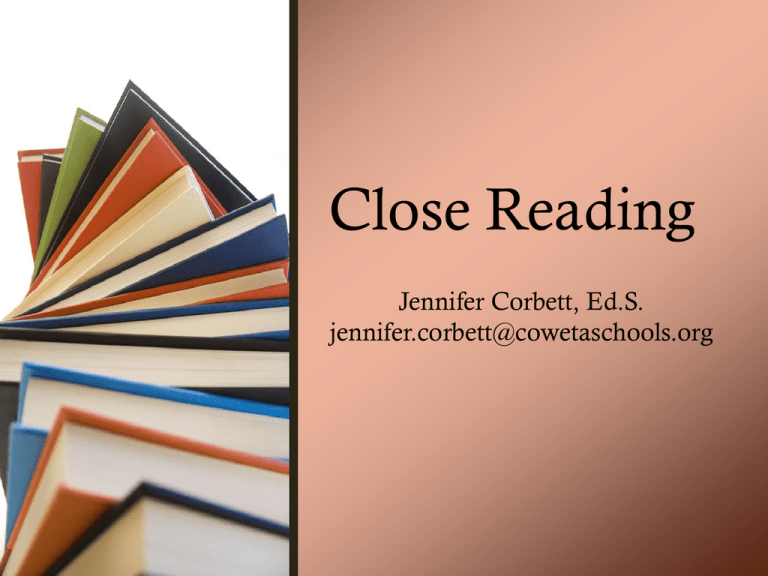
Close Reading Jennifer Corbett, Ed.S. jennifer.corbett@cowetaschools.org Overview Research Close reading instruction Practices Short texts Rereading Text-dependent questions Annotation After-reading tasks Application Objectives To know the importance, key principles, and indicators of modeling thinking of complex text through thinkalouds, demonstrations, and annotation Identify characteristics of a quality purpose statement, understand how a quality purpose statement will support students in accessing complex texts, and engage in and complete tasks assigned What is close reading? Essentially, close reading means reading to uncover layers of meaning that lead to deep comprehension (Boyles, 2013). Close reading is an instructional routine in which students critically examine a text, especially through repeated readings (Fisher & Frey, 2012). Why close reading? With the increase of rigor due to the Common Core State Standards, every student needs to learn academic English (Barrow, 2014). Common Core State Standard – ELACC RI & RL ELACC6RL1: Cite textual evidence to support analysis of what the text says explicitly as well as inferences drawn from the text. PARCC standard Common Core PARCC Short texts – literary & informational Folktales Short articles Legends Biographies Myths Personal narratives Short stories Poetry Scenes from plays Sections of a novel (a sentence, paragraph, or page) Example – scene from a play An extended metaphor from Anne Frank: Diary of a Young Girl We’ve had bad news. The people from whom Miep got our ration books have been arrested. So we have had to cut down on our food. Our stomachs are so empty that they rumble and make strange noises, all in different keys. Mr. Van Daan’s is deep and low, like a bass fiddle. Mine is high, whistling like a flute. As we all sit around waiting for supper, it’s like an orchestra tuning up. It only needs Toscanini to raise his baton and we’d be off in the “Ride of the Valkyries.” Rereading The idea To expand the reader’s purpose with each rereading Students look for evidence to cite in response to specific questions Rereading can be completed independently with peers, or through think-alouds Rereading Why the Bear Has a Short Tail (on LearnZillion) Sources Video (6 minutes) Power Point Handout of notes for rereading Copy of the story Think-alouds Generally more appropriate for k-3 An intro to annotation using sticky notes One significant difference between a think aloud and a read aloud is that during a read aloud you teach (for example, predictions, character traits, beginning, middle and end, story elements and so forth). However, during a think aloud you model your thinking (in other words your reading comprehension) out loud as you read (Patsalides, 2012). Whole Question Types Across Text Opinions, Arguments Intertextual Connections Entire Text Inferences Segments Author’s Purpose Paragraph Vocabulary and Text Structure Sentence Word Part Key Details General Understanding Text Dependent Questions Click here to read Eleven by Sandra Cisneros Question type General understanding After line 75, retell what’s happened to Rachel up to this point in the story? Key Details In lines 16 – 19 Rachel compares growing old to three different things. Tell how all three things are alike. Explain in your own words Rachel’s idea about growing up. Vocabulary & Test Structure Read the boxed paragraph a couple of times to yourself. Notice the words and phrases that help you experience Rachel’s feelings in your imagination. Author’s Purpose From what point of view is this story told? Circle the pronouns in lines 24 – 30. Inferences What do you infer about how Mrs. Price feels about Rachel? What do you infer about Mrs. Price’s character? Opinions, Arguments, Intertextual Connections In your opinion, do you think the teacher handled this situation appropriately? What could she have done differently to find the owner of the sweater? Craft technique & possible questions Figurative language • simile • metaphor • personification • symbols What is being compared? Why is the comparison effective? What symbols are present? Why did the author choose these symbols? Word choice What words stand out and why? Did the author use nonstandard English? Why? What was the effect? Tone and voice What one word describes the tone? Is the voice formal or informal? Does the voice seem appropriate for the content? • • • • Sentence structure Short sentences Long sentences Sentence fragments Why did the author choose a short sentence here? Why did the author write a fragment here? Your turn Let’s take a short passage and create a table of textdependent questions based on the two examples presented. Annotating texts Before reading Make predictions During reading Ask questions After reading State opinions Free lesson plans online to introduce students to annotating texts Analyze author’s craft Activities also available with textbooks (i.e. Holt) Reflect AKA Dialogue with Text Make connections Modeling annotation Model texts with annotations (from previous students) “They can see that there is no one right way to annotate but that there are patterns and categories that seem to be used by readers as they work to make sense of their reading.” (Porter-O’Donnell, 2004). Alternatives for students with no books Photocopy selected documents and public domain texts Keep a dialectical journal information interpretation Student work sample Annotation Teachers Pay Teachers Pinterest bookmarks Classroom posters Close Read Close re Close ad re Close ad re Close re ad ad Close Read by Tracy Watanabe is licensed under a Creative Commons Attribution 3.0 Unported License. 1 1st Read: Students read and annotate 2 Students think and quick write 3 Students talk with partner 4 2nd Read: Teacher reads, students listen 5 Think, write, talk 6 3rd Read: Listen and watch while teacher reads and annotates 7 4th Read: Students reread to find answers and evidence 8 Respond in writing, citing evidence from the text Close listening Interactive read-alouds (Fisher, Flood, Lapp & Frey, 2004) Text-based questions are answered orally Because children’s listening comprehension outpaces their reading comprehension in the early grades, it’s important that your students build knowledge through being read to as well as through independent reading, with the balance gradually shifting to silent, independent reading (Boyles, 2013). Jigsaw - Earth Science Storms thunderstorms tornadoes snowstorms hurricanes Additional Strategies Vocabulary Get moving (Barrow, 2014) Chunking Clunks & clues organizer (ReadWriteThink.org) Student/teacher conference Conference form for reread and close read (Robb, 2009) Practice From Natalie Babbitt’s Tuck Everlasting How would you use close reading to guide students to understanding how the man in the yellow suit and the constable got along during their ride in chapter 16? FYI – the typical response is, “Good.” What if the students were to role play this? References Barrow, M. (2014). Evan math requires learning academic language. Phi Delta Kappan, 95 (6), 35-38. Boyles, N. (2013). Closing in on close reading. Educational Leadership, 70 (4), 36-41. Fisher, D. & Frey, N. (2012). Close reading in elementary schools. The Reading Teacher, 66 (3), 179-188. Fisher, D. & Frey, N. (2013). Rigorous reading. Thousand Oaks: Corwin. Partnership for Assessment of Readiness for College and Careers. (2014). Structure of the model content frameworks for ELA/literacy. Retrieved June 8, 2014, from http://www.parcconline.org/mcf/english-language-artsliteracy/structure-model-contentframeworks-elaliteracy Patsalides, L. (2012). Think aloud: The new read aloud. Retrieved June 9, 2014, from http://www.brighthubeducation.com/middle-school-science-lessons/4014chrysanthemum-lesson-plan/?cid=parsely_rec# Porter-O’Donnell, C. (2004). Beyond the yellow highlighter: Teaching annotation skills to improve reading comprehension. English Journal, 93 (5), 82-89. Robb, L. (2009). Assessments for differentiating reading instruction. New York: Scholastic, Inc.

